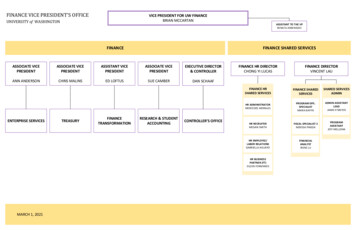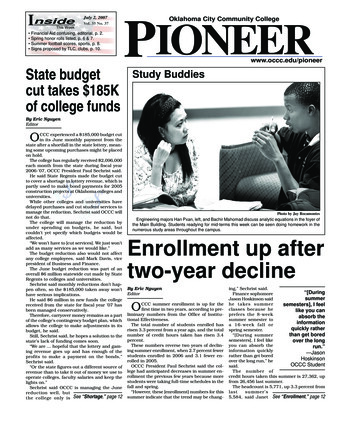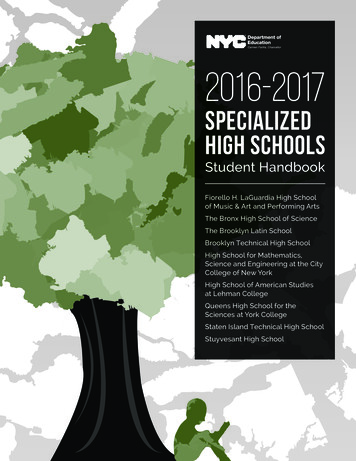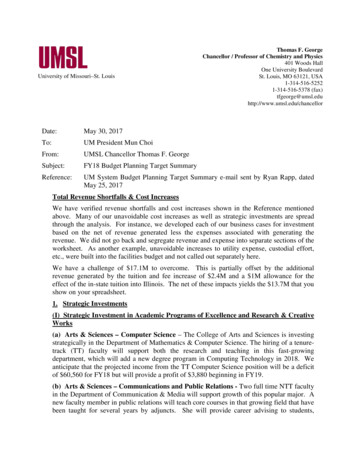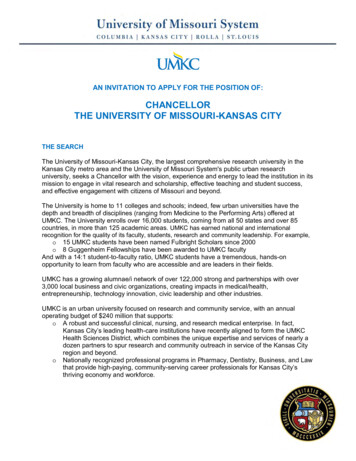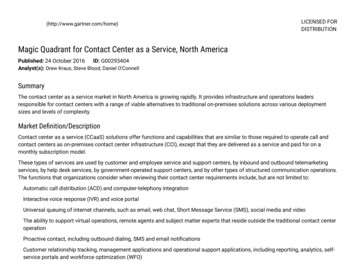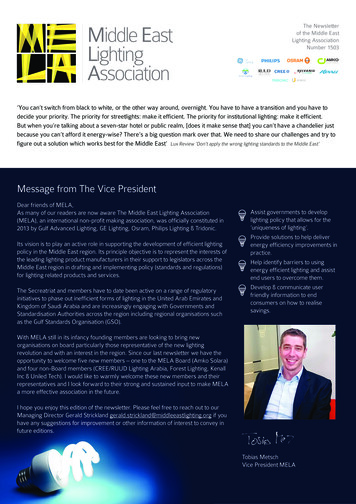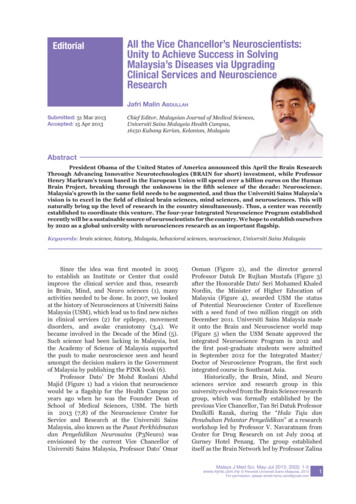
Transcription
EditorialAll the Vice Chancellor’s Neuroscientists:Unity to Achieve Success in SolvingMalaysia’s Diseases via UpgradingClinical Services and NeuroscienceResearchJafri Malin AbdullahSubmitted: 31 Mar 2013Accepted: 15 Apr 2013Chief Editor, Malaysian Journal of Medical Sciences,Universiti Sains Malaysia Health Campus,16150 Kubang Kerian, Kelantan, MalaysiaAbstractPresident Obama of the United States of America announced this April the Brain ResearchThrough Advancing Innovative Neurotechnologies (BRAIN for short) investment, while ProfessorHenry Markram’s team based in the European Union will spend over a billion euros on the HumanBrain Project, breaking through the unknowns in the fifth science of the decade: Neuroscience.Malaysia's growth in the same field needs to be augmented, and thus the Universiti Sains Malaysia’svision is to excel in the field of clinical brain sciences, mind sciences, and neurosciences. This willnaturally bring up the level of research in the country simultaneously. Thus, a center was recentlyestablished to coordinate this venture. The four-year Integrated Neuroscience Program establishedrecently will be a sustainable source of neuroscientists for the country. We hope to establish ourselvesby 2020 as a global university with neurosciences research as an important flagship.Keywords: brain science, history, Malaysia, behavioral sciences, neuroscience, Universiti Sains MalaysiaSince the idea was first mooted in 2005to establish an Institute or Center that couldimprove the clinical service and thus, researchin Brain, Mind, and Neuro sciences (1), manyactivities needed to be done. In 2007, we lookedat the history of Neurosciences at Universiti SainsMalaysia (USM), which lead us to find new nichesin clinical services (2) for epilepsy, movementdisorders, and awake craniotomy (3,4). Webecame involved in the Decade of the Mind (5).Such science had been lacking in Malaysia, butthe Academy of Science of Malaysia supportedthe push to make neuroscience seen and heardamongst the decision makers in the Governmentof Malaysia by publishing the PINK book (6).Professor Dato’ Dr Mohd Roslani AbdulMajid (Figure 1) had a vision that neurosciencewould be a flagship for the Health Campus 20years ago when he was the Founder Dean ofSchool of Medical Sciences, USM. The birthin 2013 (7,8) of the Neuroscience Center forService and Research at the Universiti SainsMalaysia, also known as the Pusat Perkhidmatandan Penyelidikan Neurosains (P3Neuro) wasenvisioned by the current Vice Chancellor ofUniversiti Sains Malaysia, Professor Dato’ OmarOsman (Figure 2), and the director generalProfessor Datuk Dr Rujhan Mustafa (Figure 3)after the Honorable Dato' Seri Mohamed KhaledNordin, the Minister of Higher Education ofMalaysia (Figure 4), awarded USM the statusof Potential Neuroscience Center of Excellencewith a seed fund of two million ringgit on 16thDecember 2011. Universiti Sains Malaysia madeit onto the Brain and Neuroscience world map(Figure 5) when the USM Senate approved theintegrated Neuroscience Program in 2012 andthe first post-graduate students were admittedin September 2012 for the Integrated Master/Doctor of Neuroscience Program, the first suchintegrated course in Southeast Asia.Historically, the Brain, Mind, and Neurosciences service and research group in thisuniversity evolved from the Brain Science researchgroup, which was formally established by theprevious Vice Chancellor, Tan Sri Datuk ProfessorDzulkifli Razak, during the “Hala Tuju danPenubuhan Pelantar Penyelidikan” at a researchworkshop led by Professor V. Navaratnam fromCenter for Drug Research on 1st July 2004 atGurney Hotel Penang. The group establisheditself as the Brain Network led by Professor ZalinaMalays J Med Sci. May-Jul 2013; 20(3): 1-5www.mjms.usm.my Penerbit Universiti Sains Malaysia, 2013For permission, please email:mjms.usm@gmail.com1
Malays J Med Sci. May-Jul 2013; 20(3): 1-5Ismail. Five years later on 29th October 2009,the Brain Mind Nexus was established aftera meeting chaired by Professor Asma Ismail,the USM Deputy Vice Chancellor (Researchand Innovation), with Professor Zalina Ismailcontinuing on as the head of the Nexus,which included many fellow researchers ascollaborators; Professor Jafri Malin Abdullah,Professor Kamarulazizi Ibrahim, ProfessorMohd Zaid Abdullah, Professor Ruzhan M.Idrus, Professor Susie See Ching Mey, AssociateProfessor K. Sudesh Kumar, Associate ProfessorWan Ahmad Kamil Wan Abdullah, and AssociateProfessor Zainal Ariffin Ahmad.The metamorphosis in teaching includedthe Master of Surgery (Neurosurgery) established12 years ago in 2001 by the School of MedicalSciences, Universiti Sains Malaysia under thefourth Dean of the School, Professor Dr ZabidiAzhar Hussin (Figure 6), The program hasproduced 32 neurosurgeons working both ingovernment and private practice. Then theAdvanced Master of Medicine (Neurology) wasestablished under the fifth dean, Professor Dr AzizBaba (Figure 7), with the first batch graduating inMay 2010. Dr Shalini Bhaskar (Figure 8) was thefirst neurologist from the three-year program.She was taught by Professor John Tharakan(Figure 9), who also initiated the Epilepsy Surgery(ES) as well as the Deep Brain Stimulation (DBS)programs for movement disorders and taughtneurology to the 32 neurosurgical trainees.Thus, came the words: “Examine the patient likeJohn Tharakan and operate on the patient likeYasargil.” The first five cohorts of neurosurgicaltrainees were also taught by the previous Chair ofthe Department of Neurosurgery at UniversitairZiekenhuis Ghent, Belgium, Professor LucCalliauw (Figure 10), who became a favouritevisiting professor. Neurosurgery thus, underwent“Calliauwisation” amongst the younger generationof neurosurgeons in Malaysia, including thecurrent Associate Professor Zamzuri Idris, Dato’Dr Abdul Rahman Izaini Ghani and Dr BadrisyahIdrus, who became members of the Departmentof Neurosciences.The first batch of students with a Master ofNeuroscience and PhD by pure research modegraduated in 2008. Of other Malaysian-bredneuroscientists, a third are overseas doing theirPhD training in Germany, Switzerland, Ireland,Australia, and the United Kingdom. Dr FarizanAhmad from the first batch of neuroscientist fromUSM returned from University of Eastern Finlandwith a PhD in the field of Gene Therapy.The return of Dr Muzaimi Mustapha from2www.mjms.usm.mythe United Kingdom in 2009 (Figure 11) helpedme push the agenda to bring post-graduateneuroscience to another higher level. Havinggraduated with both an undergraduate medicaldegree and a PhD from University of Cardiff,exposing him to the Integrated Neuroscienceprogram there, Dr Muzaimi was seen to be ascion who could evolve the still existing pureresearch program and initiated to an integratedone. I noticed that as in many other neurosciencepost-graduate programs organized by pureresearch modes, students were struggling as theirfirst degrees were not from neurosciences ormedicine or pharmacy, and they had to learn andrelearn many aspects of neurosciences withoutproper modules or examinations. He managedto set up the syllabus as well as follow the strictrequirements of the Malaysian QualificationAgency with the assistance of more than25 lecturers from different schools in thisuniversity.I also asked Dr Muzaimi to be the editor ofthe first Southeast Asian Neuroscience Journal,The Orient Neuron Nexus, which was establishedJune 2010. I noticed that neuroscience was nota common research topic in Southeast Asiancountries, except Singapore, the source of mostof the publications in Brain, Mind, and Neurosciences.Sustainability was another big problem, aspost-doctoral fellows mainly from the Indiansubcontinent would come and go without a goodgroup of replacement neuroscientists and futureacademicians. I remembered having a meetingon Saturday, October 24th, 2009 at 10 am inthe Department of Radiotherapy, Oncology andNuclear Medicine Meeting Room with 17 lecturersand trainee lecturers from the different fields ofRadiology, Physics, Chemistry, Biology, VeterinaryMedicine, Biomedicine, Psychology, Medicine,and Computer Sciences where we decided thateveryone should not duplicate each others’ fieldswhen doing their PhDs and that the commondenominator was both human and animalneuroimaging as well as behavioral neurosciencessupported by neurophysics, computationalneurosciences, and neuroinformatics (Figure12). This has lead to our trainees doing color andvision experiments in non-human primates withfunctional magnetic resonance imaging (fMRI),neuropsychology and electroencephalography(EEG), neurofeedback and fMRI, Ultra HighField 7 Tesla fMRI and visual neurosciences, drugdiscovery and EEG, medicinal chemistry andelectrophysiology, stem cell therapy in animalmodels as well as neuro-oncology to supplement
Editorial Neurosciences Service and Research in Universiti Sains Malaysiathe existing Cellular and Molecular Neurosciencesgroup in the Department of Neurosciences, Schoolof Medical Sciences, USM.The existing specialties in clinical servicein this University had been the DBS and ESprograms. The last year has seen an increase inthe use of intraoperative radiotherapy, awakecraniotomy for tumors in eloquent areas in thebrain, surgery for spasticity, minimal invasiveneurosurgery guided by functional MRI, EEGas well as Magnetoencephalography (MEG),transcranial magnetic stimulation (TCMS) forbrain mapping and motor cortex augmentationafter brachial plexus anastomosis. Most recentlywe initiated our neuropsychology assessmentand rehabilitation for traumatic brain injuryand cerebrovascular disease patients as well as ahuman leukocyte antigen (HLA) and biomarkerservice for antiepileptic drugs, anti-platelettherapy, tumor markers for chemotherapy andradiotherapy.We signed Memoranda of Understandingwith numerous institutions. For example, atthe Cuban Neuroscience Center in the field ofNeuroinformatics we cooperated with ProfessorMitchell Valdes Sosa and Professor Pedro ValdesSosa (Figure 13); at the Center for IntelligentSignal and Imaging Research at the UniversitiTeknologi PETRONAS in the field of ArtificialIntelligence and Cognitive Neuroscience and1234678951011Figure 1:Professor Emeritus Dato’ Dr Mohd Roslani bin Abdul Majid, Founding Dean of the Schoolof Medical Sciences.Figure 2:Professor Dato’ Dr Omar Osman, the Vice Chancellor of Universiti Sains Malaysia.Figure 3:Professor Dato’ Dr Rujhan Mustafa, the Director General of the Ministry of HigherEducation Malaysia.Figure 4:The Honorable Datuk Seri Mohamed Khaled Nordin, the Ministry of Higher Education,Malaysia.Figure 5:First batch of Integrated Neuroscience Program, candidates with lecturers involved in theneuroscience teaching program.Figure 6:Professor Dr Zabidi Azhar Hussin, 4th Dean of School of Medical Sciences, UniversitiSains Malaysia.Figure 7:Professor Dr Aziz Baba, 5th Dean of School of Medical Sciences, Universiti Sains Malaysia.Figure 8:Dr Shalini Bhaskar, first graduate of the Advanced Master of Medicine (Neurology)Program.Figure 9:Professor John Tharakan, started the first Advanced Master of Medicine (Neurology)Program.Figure 10: Professor Luc Calliauw, previous Head of Department of Neurosurgery, UniversityHospital Ghent, Belgium, who visited Universiti Sains Malaysia numerous times.Figure 11:Dr Muzaimi Mustapha, coordinator of Integrated Neuroscience Program, School ofMedical Sciences, Universiti Sains Malaysia. He is the current Editor of the Orient NeuronNexus.www.mjms.usm.my3
Malays J Med Sci. May-Jul 2013; 20(3): 1-5Epileptology with the collaboration of ProfessorIr Dr Ahmad Fadzil bin Mohd Hani DeputyVice Chancellor Academic, Universiti TeknologiPETRONAS; at Universiti Malaysia Trengganu inthe field of stem cell growth factor research; at TheSpastic Children’s Associatio n of Selangor andFederal Territory to increase the care of spasticchildren that may need specialized neurosurgicalcare.We hope to sign scientific cooperationagreements with the European NeuroscienceInstitute at the University of Goettingen,Germany forseen in the mid of 2013 collaboratingwith Professor Micheal Horner (Figure 14).This idea came about thanks to Hans ReinerPolder of npi electronic GmbH, Instruments forthe Life Sciences (Figure 15) who co-organised12two Deutscher Akademischer Austauschdienst(DAAD) Fundamental ElectrophysiologyNeuroscience summer schools with us.The fate of Brain, Mind and Neuro scienceswithin Asia (9–12) depends on China, Japan,India and South Korea leading, and Singapore andMalaysia following. The neuroscience innovatorsfrom the different universities in Asia will soonbe the biggest contributor to biotechnology andindustrial growth in Asia. It will require muchcollaboration and strong fundamental knowledgeto match the Human Brain Project (13) as wellas USA’s Brain Research through AdvancingInnovative Neurotechnologies (14). I hope thatthe recent launching of the Neuroscience centerwill lead to excellent growth in the field of researchin the brain and neuro sciences (Figure 16a,b,c).131415Figure 12: Trainee neuroscience lecturers from the Department of Neurosciences as well as theSchool of Medical Sciences meeting on the 24th October 2009 to decide on their PhDtracks and specialisations.Figure 13: Visiting Professor Pedro Valdes Sosa from the Cuban Neuroscience Center.Figure 14: Professor Michael Hörner who coordinated and organised the first and second DAADworkshops in Malaysia.Figure 15: Hans Reiner Polder initiated the set up of electrophysiology lab in the School of Medicine,Universiti Sains Malaysia.aFigure 16(a,b,c):4www.mjms.usm.mybcLaunching of the ‘Pusat Perkhidmatan dan Penyelidikan Neurosains (P3 Neuro)’known as Center for Neuroscience Service and Research, USM (CNSR) by theVice Chancellor of Universiti Sains Malaysia Professor Dato’ Dr Omar Osman onthe 17th April 2013 in the USM, Health Campus.
Editorial Neurosciences Service and Research in Universiti Sains MalaysiaAcknowledgementThe Editor acknowledges the contributionsof the present & previous Vice Chancellorsand their deputies of USM, Deans, and theirdeputies of various Schools; past and present,lecturers/specialists who supported the brainand neurosciences initiative from the USM'sfive campuses both past and present, visitingProfessors, Associate and Adjunct Lecturers,the neuroscience supporting staff, scientists,post-doctor fellows, Master and PhD studentsand graduates, Advance Master of Medicine(Neurology) and Master of Surgery (Neurosurgery)graduates as well as the Integrated NeuroscienceProgram students for elevating UniversitiSains Malaysia to the next level of excellence inneuroscience clinical service and research. ProfJafri Malin Abdullah, was elected as P3 Neuro’sfirst founding director in 2013.4.Zamzuri I, Nazaruddin WM, Muzaimi M, BadrisyahI, Rahman IG, Jafri MA. Functional MRI, DiffusionTensor Imaging, Magnetic Source Imaging andIntraoperative Neuromonitoring Guided Brain TumorResection in Awake and Under General Anaesthesia.In: Terry L, editor. Clinical Management andEvolving Novel Therapeutic Strategies for Patientswith Brain Tumors. New York (NY): InTech; 2013. p.17–54.5.Olds JL. For an international decade of the mind.Malays J Med Sci. 2011;18(2):1–2.6.Abdullah JM. The Decade of the Mind 2010 to2020: How Malaysian neuroscientists can createknowledge, skills and innovative research to drivethe 10th and 11th Malaysia Plan within the NewEconomic Model. Kuala Lumpur (MY): AkademiSains Malaysia; 2010.7.Profesor Dato’ Dr Omar Osman. Bersama UntukKecemerlangan Universiti: Menzahir Kejayaan.Malaysia (MY): Penerbit Usm; 2012.8.Profesor Dato’ Dr Omar Osman. Together forUniversity’s Excellence: Synergizing the Ecosphereof University for Excellence. Malaysia (MY): PenerbitUsm; 2013.9.Amara SG, Grillner S, Insel T, Nutt D, TsumotoT. Neuroscience in recession? Nat Rev Neurosci.2011;12(5):297–302. doi: 10.1038/nrn3023.CorrespondenceProfessor Dr Jafri Malin AbdullahFAM (Malaysia), FASc (Malaysia), MD (UniversitiSains Malaysia), PhD (University of Ghent), FRCS (Ed),FACS (USA), DSC Neurosurgery (Belgium)Malaysian Journal of Medical SciencesUniversiti Sains Malaysia Health Campus16150 Kubang KerianKelantan, MalaysiaTel: 609-767 6972Fax: 609-767 2359Email: mjms.usm@gmail.com10. Cyranoski D. Neuroscience in China: 1038/476022a.11. Poo MM, Sander L, Fivaz M, Hayashi Y. Asian promise:the state and future of collaborations in neuroscience.Nat Rev Neurosci. 2008;9(11):881–884.12. Cyranoski D. Neuroscience: Thought experiment.Nature. 2011;469(7329):148–149.References13. Markam H. The human brain project. Sci Am.2012;306(6):50-55.1.Abdullah JM. Neurosciences in University SainsMalaysia; The Way to Go Forward in Malaysia withVision 2020. Malays J Med Sci. 2005;12(2):1–3.2.Idris B, Sayuti S, Abdullah JM. History of neurosciencesat the School of Medical Sciences, Universiti SainsMalaysia. J Clin Neurosci. 2007;14(2):148–152.14. Underwood E. Neuroscience. Brain projectdraws presidential interest, but mixed reactions.Science. 2013;39(6123):1022–1023. doi: 10.1126/science.339.6123.1022.3.Mohd Nazaruddin WH, Mohd Fahmi L, LailaAM, Zamzuri I, Abdul Rahman IZ, Hardy MZ.Awake Craniotomy: A Case Series of AnaestheticManagement using a Combination of Scalp Block,Dexmedetomidine and Remifentanil in HospitalUniversiti Sains Malaysia. Med J Malaysia.2013;68(1):64–66.www.mjms.usm.my5
programs for movement disorders and taught neurology to the 32 neurosurgical trainees. Thus, came the words: “Examine the patient like . post-graduate programs organized by pure research modes, students were struggling as their . supported by neurophysics,
